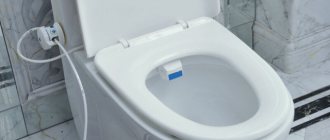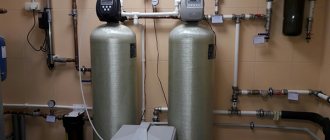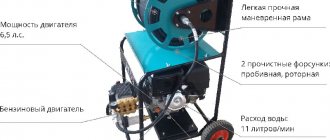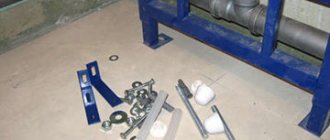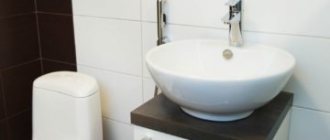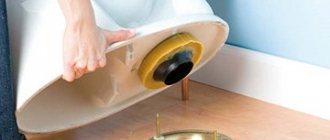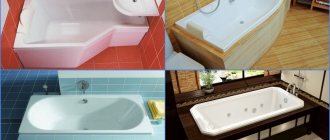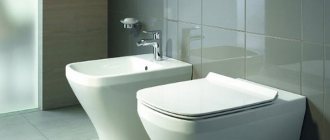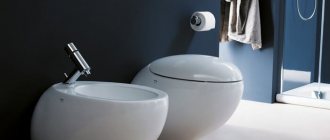Purpose and design of a hygienic shower
The direct purpose of a hygienic shower for the toilet is to maintain the cleanliness of intimate places. However, in addition to this function, the device is often used for cleaning the toilet, as well as for washing other items, such as pots or shoes.
The package includes the following items:
- mixer;
- hose;
- holder;
- watering can with off/on button.
The hose is made of polymer materials and plastic, its length reaches 2 m.
Mixers are necessary to regulate the temperature. More expensive models are equipped with a thermostat, which allows you to adjust the degree of heating of the liquid once and not think about it anymore. A shower without a faucet would only supply cold or hot water. The watering can is equipped with a key for adjusting the flow of liquid. You can choose a narrower but dense one, or a rain one with small drops.
Hygienic shower for washing shoes.
The holder performs not only an aesthetic function in the interior, it is necessary for fixing the watering can while taking a shower and so that there is somewhere to hang the device after use.
How to choose the right bath mixer?
You need to choose faucets from models of popular manufacturers and, if possible, do not skimp on them. The more expensive the water intake fittings are, the longer they will last. Due to poor quality, the device quickly becomes unusable, and the most common problem with cheap faucets is corrosion. You need to select it according to the following criteria:
- Weight. A high-quality mixer has dense walls. It shouldn't be easy.
- Material. Reliable devices are made of brass, cheap ones are made of silumin (silicon + aluminum). Brass ones are heavier and bulkier.
- Size and technical characteristics. Selected based on personal preferences and the location in which the model will be installed. When choosing, the fixation to the side of the bathtub or wall, the length of the hose and faucet spout, and additional fasteners in the kit are of great importance.
Main varieties
There are 4 types of hygienic shower designs:
- bidet cover;
- shower toilet;
- shower connected to the sink;
- wall-mounted shower.
Bidet lid
Electronic bidet cover.
This type of design is a mixture of a classic bidet and a toilet. It was designed to save space in bathrooms. The design is built into the toilet lid and controlled via a special panel or remote control. The device is connected to the pipeline supplying water to the toilet tank.
Electronic bidet covers perform the following functions:
- The water is heated using an electric heater.
- Most models are equipped with a hairdryer, which acts as a dryer.
- Turns on and off automatically.
- Using liquid that fills a special container, it flushes the nozzles and the toilet, i.e., it performs a sanitary function.
Bidet lid for toilet.
Shower toilet
The only difference between a shower toilet and a regular one is that the tank of the former has large dimensions, since all the electronics are built into it.
Depending on the model, it has the following features:
- The nozzle can be retractable or stationary.
- You can select the jet type and intensity of the water flow.
- Disinfects the surface of the toilet bowl with a special solution.
- There is a water heater and water temperature control.
- Hairdryer available.
Under-sink shower
Sink mixer with hygienic shower.
The shower and sink share one faucet. Installation is simple, but you will need to purchase a device with three connections: for spouting into the washbasin, connecting to the water supply and connecting the hygienic shower hose. When you turn the faucet handle on the mixer, water comes out of it over the washbasin. But as soon as you press the button on the shower head, the liquid stops going into the sink and goes into the shower head. If you release the button, water will flow over the washbasin again.
This design has the following advantages:
- The temperature can be adjusted over the sink.
- After releasing the button on the watering can, residual water will not flow onto the floor.
- It's inexpensive.
Faucet with hygienic shower.
Wall-mounted design
This type of hygienic shower is connected to the water supply network. The design consists of a mixer equipped with temperature control valves, a hose and a watering can attached to the wall using a holder. Of all the options, this is the most convenient and easiest in technical terms, since installation can be done independently; you can use ready-made connection diagrams.
Accessories and useful little things
Accessories play a big role in making the bathroom convenient and comfortable. They are usually concentrated around the place of daily hygiene procedures - the sink.
It is absolutely impossible to do without a soap dish and a heated towel rail. The choice depends on the owner of the apartment. At the same time, it is necessary to take into account the needs of other family members, especially children, for whom the location of the soap dish is crucial: will the child be like a pig, or will he learn to use soap from an early age.
The market, especially the Chinese one, offers an unimaginable number of devices and “gadgets” that can be used to improve the place in which a person feels in the intimate area.
Another question. Are ions needed and how useful are they, given the low quality and dubious effect of their use?
Know-how of the market for “useful” accessories:
- display built into the mixer handle;
- touch sensors that turn on water when you raise your hands to the sink;
- voice control on/off water;
- automatic supply of liquid soap;
- air dryers for hands and face;
- automatic dispensers of shaving cream/gel;
- plugs – traps for debris and hair;
- shelf for toiletries made of sandalwood;
- holder for toothpaste tubes;
- LED illumination of the stream of water flowing from the mixer spout.
The list goes on. The question is, how useful are these devices? Given their extremely short service life, this is a way to defraud consumers who are greedy for toys.
To install a faucet in a bathroom in accordance with the requirements of GOST and SNiP, no deep knowledge is required. We tried to provide and illustrate the optimal installation heights for sinks, which coincide with the average height of Russian residents and the requirements that guide builders when installing pipelines.
Every apartment owner is free to change the height of the sink in the bathroom. This is not punishable.
Types of faucets for hygienic showers
Mixers come in three types:
- Faucets equipped with valves are mounted under the sink, because they need a device for supplying liquid. The design includes two valves, one of which is responsible for supplying cold water, and the other for hot water. By turning these valves, you can achieve the desired temperature. This design is affordable, but inconvenient to use. If the water pressure in the system drops, the temperature of the liquid at the outlet will begin to change sharply.
- Faucets equipped with a lever are much more convenient. The control element is a lever, the vertical movement of which regulates the water pressure at the outlet, and the horizontal movement - the temperature. Convenient to use.
- Faucets equipped with a thermostat are the most modern and expensive models. The main element in their design is a thermostat, the operating principle of which is to automatically adjust the set temperature. When used for the first time, a person sets the desired indicator, then the device defaults to the previously set value. If the pressure in the water pipe drops, the system will independently determine the volumes of cold and hot water to achieve the set temperature.
Built-in thermostat for hygienic shower.
Why are the dimensions of the shower stall important?
Before purchasing a large shower stall, it is important to know not only the dimensions of the product, but also the dimensions of the bathroom. Since the inability to install the unit in the bathroom will lead to the need to replace it, which means that you will have to pay extra for freight transportation and loading and unloading of the cabin
It happens that the bowl of the tray does not fit into the previously prepared place, and the doors, even without a canopy, do not fit into the height of the bathroom. Therefore, before choosing and installing, it is necessary to measure the dimensions of the free space and the height of the ceiling.
The height of the trays in some models exceeds 40 cm, and the glass doors of the cabin reach 175 cm and higher. Then the total height of the sanitary ware will be 225 cm. If a lid is installed on top of the flask, for example, in a closed cabin, then it is necessary to leave 15-20 cm to be able to install the upper dome.
Bathtub showers can be even taller due to the significant height of the immersion tank. Some models are equipped with additional legs.
Standard length, width of the shower stall is 80-90 cm. Such sanitary ware will fit in almost any bathroom. But products with a bathtub tray or with the longest base of 197 cm can be installed only by owners of a medium-sized or large bathroom.
Methods for installing a hygienic shower
By following the instructions, you can install the shower yourself.
Regardless of the type of device, before connecting it to the water supply system, it is necessary to perform the following preparatory work:
- Choose a location. The installation height of the mixer and watering can above the floor should be such that a person can easily reach them without standing up. The watering can holder can be mounted above the toilet.
- Depending on the location of the pipelines, it is necessary to mark the wall for laying the pipes.
- If hidden installation of hygienic shower elements is carried out, it is necessary to ditch the walls.
Hygienic shower mixer on the wall.
All further actions depend on the type of device.
Wall installation
The wall-mounted version is installed in 2 ways: open and closed. The first one is much easier and cheaper. To implement the second, you will have to make a niche in the wall for laying hot and cold water supply pipelines, then carry out the cladding.
Connection diagram for a hygienic shower.
To install a shower, you need to shut off the liquid supply in the apartment, and then install tees in the pipes. Through one of the three tee pipes, hot and cold water will flow into the mixer.
Installation of the bidet cover
After purchasing a new bidet seat, you need to remove the old lid from the toilet by unscrewing the plastic wings.
Before connecting the bidet lid to the pipeline, you need to close the shut-off valve on the line leading water to the toilet cistern. The line is then removed and a tee is installed. It has three pipes, two of which are equipped with internal threads, and one with external threads. The pipes with internal threads are placed vertically: the line leading to the toilet tank is connected to the upper one, and the lower one is connected to the water supply network. The remaining one is used to attach the bidet lid to the tee.
Sink installation
If there is a sink near the toilet, then you can install a hygienic shower in the toilet yourself.
Installation of a hygienic shower.
To do this you need to purchase the following items:
- Mixer.
- The hygienic shower itself and everything that comes with it is standard: studs, nuts and O-rings.
- Hoses.
- Shut-off valves.
- Keys.
Installation is carried out as follows:
- A description of all elements is given in the product instructions. Therefore, before proceeding with installation, it is recommended to carefully study it.
- After installing all the necessary gaskets according to the instructions, you need to check their tightness. If the fasteners are not tight, the system may leak in the future.
- Then install three flexible hoses. Two of them deliver hot and cold water to the faucet, and the third goes from the faucet to the shower head. A watering can is connected to its free end.
- Now start assembling the holder. The distance between it and the toilet should be such that you can take out the watering can and hang it on the holder without getting up.
- After all work is completed, open the water supply and check the system for leaks. If everything is done correctly, they will not exist. If a leak is detected, the corresponding components are dismantled and the condition of the gaskets and seals is checked.
The process of installing a shower under the sink can be seen in the video below.
Combination of devices
In modern apartments with a small area, developers have almost completely abandoned the comfortable and hygienically safe separate bathrooms and toilets. More than 70% of small apartments have a combined bathroom.
This forces homeowners to resort to various tricks. In order to optimize the space in which, in addition to the toilet and washbasin, it is necessary to place a bath or shower. The vast majority of the Russian population is a fan of placing a washing machine in the bathroom.
The tightness of the room forces the use of combined appliances - mixer taps. Usually, in order to save money, when the bathtub and sink are located close together, one common faucet with a swivel gib and a shower head is installed, which allows you to use both devices.
Often in a cramped room there is no space for a bidet. In this case, the flexible hose with the shower head is extended, which replaces the bidet nozzle.
SNiP does not provide special rules that would regulate such creativity. In any case, it is more convenient and safer, in terms of preventing possible leaks, to equip each plumbing product with an independent tap or mixer.
This reduces the load on the valve system, extends the service life, and makes the valves repairable. If one faucet fails, you can still use others.
Popular manufacturers of hygienic showers
In the ranking of the best manufacturers, the leading positions are occupied by manufacturers from Germany. The Grohe and Hansgrohe brands have gained particular popularity.
Grohe BauCurve 123072 is a built-in model with a single-lever mixer and chrome finish. To place it you will need two holes in the wall. The flexible hose allows you to choose the location relative to the toilet, placing the faucet and watering can in different places.
Grohe BauEdge 23757000 is another model equipped with one lever for adjusting water pressure and temperature. Connects to the sink.
Lemark Solo LM7165C is a built-in bidet model with a brass body. The watering can holder and the mixer are combined into one common element, which is mounted on the wall.
Hygienic shower Lemark Solo LM7165C.
Oras Saga 3912F - model connected to the washbasin. Single lever mixer, installed horizontally, chrome plated.
Similar articles
How does a shower thermostat work?
What types of bathroom faucets are there?
Which battery to install in the bathroom
Should I follow the standard?
Most builders, finishers and plumbers are well aware that the standard, optimal height of a bathroom sink is 85 cm.
These standards were developed and tested back in Soviet times, but are still observed, especially when arranging bathrooms in administrative and commercial buildings. When renovating a private apartment, if necessary, you can deviate from the generally accepted installation standard.
- Increasing or decreasing the installation height of the washbasin is not considered redevelopment, so this procedure can be performed without any additional approvals. The main thing is to correctly determine the most convenient level and securely fix the sink.
- Rearranging and changing the locations of plumbing fixtures in the bathroom of an apartment in an apartment building is allowed. You do not need to obtain additional permission for this. However, after completion of the work, it is necessary to invite a specialist from the service company to make sure that the changes made do not affect the operation of the general sewerage and water supply system.
- The installation of additional plumbing equipment, for example, a second sink or bidet, also does not require approval, provided that all plumbing equipment remains within the bathroom area. Removing the sink outside the bathroom is considered a remodel and requires the consent of regulatory authorities. Unauthorized redevelopment threatens with a large fine.
In conclusion, I would like to say that inside your apartment, and even more so in a private house, you have the right to install a sink inside the bathroom at any height convenient in specific conditions.
Whether or not to follow installation standards is up to you to decide. However, years of practice and scientific research confirm that, after all, a height of 85 cm is the most optimal option for the convenience of all family members, proven over the years.
Important Calculations
After purchasing the device, before starting the installation procedure, you must perform the following calculations: the height of the location should be approximately 60-80 cm from the floor.
To fully verify the convenience, you can sit on the toilet lid and, closing your eyes, extend your hand to where the device will be conveniently located for use. Mark this place with a pencil.
The sludge should not lie on the floor. During operation and after fastening, it must be in the air. This should be taken into account when choosing a model with a long hose. It is optimal to take a hose measuring 125 cm.
What it is?
A hygienic shower is very similar to a regular shower, only it is installed in the toilet and performs the same functions for which a bidet is intended. By resorting to this solution, the user benefits from the following:
- The free space in the bathroom remains the same. Therefore, it is possible to install a hygienic shower even in the tiniest “Khrushchev” building. In the case of a stationary bidet, you would have to allocate almost as much space for it as for the toilet.
- Ablution is performed without transferring from the toilet to any other device, which is very convenient. Especially if the user has difficulty moving due to illness or old age.
- When operating the hygienic shower head, the user can position it as he pleases. In a stationary bidet, the nozzle is fixed in a certain position.
- Equipping a bathroom with an option that is not only convenient, but also very healthy, costs mere pennies.
Along the way, a hygienic shower simplifies the solution of such problems as:
- filling large containers with water;
- cleaning the toilet;
- Rinsing a child's potty or cat litter box.
At the same time, a potential buyer should understand that the functionality of this device is minimal - it is capable of only performing basic actions.
Faucet with hygienic shower
Additional features typical of full-fledged bidets (aromatization, disinfection, and much more) will not be available. The shower also cannot heat water, so it must be connected not only to cold, but also to hot water supply.
Another important nuance: for overweight people, using a hygienic shower is quite inconvenient.
An alternative or a pointless replacement?
In terms of functionality, a concealed hygienic shower is an alternative to a bidet, but in a smaller version.
If we delve into the technical characteristics of the plumbing and consider the layout of the room, then installing a bidet requires a certain space in the room and a distance between the bathroom, which is not always enough.
Such a concealed shower is actively used in hospitals and hotels, where, according to established standards, such plumbing must be located.
The device is small in size and mounted on the wall, so valuable space is not used for a large item. This is the distinguishing feature of a hygienic shower from a bidet.
Important!
In any case, it is much easier to install a faucet connected to the toilet or sink than to buy a separate plumbing fixture. And the cost of these two items will differ radically.
Models of shower equipment for personal hygiene
Manufacturers of sanitary equipment offer a wide selection of models of shower equipment. You can buy a ready-made kit or assemble it yourself, according to your preferences for design and functionality.
Installing a hygienic shower in a toilet is impossible without cups (reflectors), which are used to hide the connection points to the water supply pipes. This must be taken into account when choosing a mixer. Each of them comes with cups. But the size (diameter) may not fit specific connection points if for some reason there are defects near them. The most common of these is chipped ceramic tiles.
Faucet selection
The mixer for a hygienic shower in the toilet can be single-lever or double-lever. There are no strict guidelines regarding this criterion. Everyone chooses the most convenient option for themselves. But it would be useful to consider the advantages of different types of mixers.
What's good about single levers:
- all manipulations are performed with one handle;
- It takes less time to perform personal hygiene procedures.
Double-lever ones are good because you can choose a model with a wider cavity volume for mixing water. This way you can quickly “catch” a comfortable temperature. Those who regularly use single-lever pumps know that they have one drawback: it is not always possible to quickly find a handle position that will allow water to flow at the desired temperature.
Advantages of faucets with thermostat
Today there are the most modern types of mixers: with a thermostat (thermostat). They can be either with one control lever or with two. Mixers of this type allow you to set a comfortable water temperature once and will maintain it constantly.
Therefore, there is no need to spend time and effort searching for the optimal position of the levers. In addition, there is one more “plus”: by opening the tap, the child will not get scalded by too hot water.
If a mixer with a thermostat is selected for the shower device, it can be separated from the watering can over a considerable distance. The fact is that equipment with a thermostat allows you to set a comfortable temperature and water pressure once. Which will continue to support us in the future.
Selecting a watering can and flexible hose
The watering can and flexible hose can be purchased separately or as a set. It's better to choose the second option. Basic requirements for these shower elements:
- tightness of connections between each other;
- anti-corrosion;
- ease of use;
- attractive appearance.
For a hygienic shower, it does not make sense to buy a long flexible hose. A fairly short one is 1.25 m. This is the standard length for shower sets of this type.
Installation on the wall in the bathroom
Wall mounting the device is the most common choice. After installation, to increase service life, you should ensure that the mixer is not constantly open. Otherwise, pressure will be present in the structure, destroying these materials.
Before starting the installation procedure, you need to shut off access to both waters.
In the next step, disconnect the flexible connection of the drain tank. Prepare a container to collect the remaining liquid.
It is necessary to disassemble the connection in the lower area of the hot water supply. If water is heated via a water heater, disconnect the plastic pipe and unscrew the coupling.
The next step is to strip the steel pipe and remove the winding. Wrap a standard tow sealer around the threads. Screw on the tee and screw the plastic tube back on.
Install a ball valve that shuts off the mixer and establish the connection.
To connect to the overall structure of the toilet, you need to install a tee into the cold water supply system. Everything is done as before: wind the tow, apply sealant, install the unit in place.
It is imperative to install a return valve on the pipe responsible for cold water supply.
When attaching the faucet, you will need a factory holder. It is included in the kit. There is an opportunity to do it yourself.
The shower head and hose are directly attached to the mixer through the adapter.
At the end of the procedure, be sure to check the system so that it does not leak water.
Functional features of the bidet watering can
Many people don't see the difference between shower heads and mini bidets. Unlike its shower prototype, the hygienic head has a number of design features.
- Smaller dimensions. That’s why it’s “mini”, to be invisible and less bulky.
- Number of nozzles. The shower head is convenient because it is equipped with a large number of nozzles through which water is supplied. The larger the work surface, the more comfortable it is to shower. On a hygienic watering can this amount is reduced to an acceptable minimum. The nozzles are thinner, which ensures minimal splashing of water during use.
The water flowing through the hygienic shower hardly splashes - Overlap pedal. This is the main difference between hygienic watering cans. The mini-bidet is equipped with a special shut-off valve. Water is supplied from the watering can only when you press the pedal, which is located on the handle.
Important! It is strictly not recommended to leave hygienic systems under pressure. This is especially harmful for the watering can. A large number of valves and connecting systems may not withstand constant pressure and the product will fail. After use, be sure to turn off the water with a mixer or other shut-off devices.
Standard dimensions of shower stalls
The stores offer a variety of plumbing booths of various shapes, colors, with minimal, normal and significant parameters, equipped with standard and additional equipment.
Most manufacturers aim to produce cabins that are standard in size and shape, since the main customers are people whose apartments have standard, small bathrooms.
If the shower stall does not have a tray or its height is 10-15 cm, then when installing a drainage system, special requirements and sealing rules must be observed to avoid flooding of neighbors
When dividing plumbing products by size, the following types of cabins can be distinguished:
- small - the dimensions of the walls of such cabins do not exceed 90 cm;
- medium-sized - the length of such units ranges from 90 to 130 cm;
- large - the walls have a length of 130 to 170 cm; there are models with even more impressive dimensions.
The height of the structures also has different characteristics, based on this, shower cabins are divided into the following types:
- low – the height of glass doors with a tray is 170-200 cm;
- high – such cabins reach a height of 240 cm or more.
Products with a height of 198–200 cm are in greatest demand.
Based on this, the smallest booths have a height of 170 cm and a maximum wall length of 75 cm. The smallest models are made symmetrically, in the shape of a square. For trailers and work houses, it is possible to manufacture symmetrical cabins with sides of 70 cm. For large models there are practically no restrictions on dimensions.
Optimal size and shape
The modern market for plumbing materials is quite extensive. The majority of shower boxes are made of plastic, the strength and quality of which is proportional to the cost of the product. The plastic used for these purposes can be transparent or colored.
The dimensions and shape of the shower stall depend on the height of the users. It should be borne in mind that they will have to stand upright, move, turn, squat or sit down. All these actions must be carried out with sufficient comfort without interference from the structure. Today there is a wide range of standard sizes on sale. You can even find shower stalls that are smaller than standard or significantly larger.
Since the size of the bathroom can vary, manufacturers offer different sizes of shower stalls.
It is worth paying attention to standard solutions
- The height of the tray is usually about 30–40 cm. If a “bathtub” is used, then the height will increase in accordance with its design.
- The height of the main structure in its standard form is approximately 210–230 cm. The smallest shower stalls are considered to be 190 cm high. The height from floor to ceiling can be 200 cm or 210 cm.
- The optimal depth is considered to be about 80 cm. There are versions with a depth of 70 cm, but they are not considered standard models. The minimum depth can be even 60 cm.
- The width can reach any size. But in its standard form it varies from 90 to 100 cm.
The dimensions of the shower stall depend, first of all, on the size of the room in which it is planned to install the shower stall. You can put a large model in a small bathroom. Nobody forbids doing this taking into account personal preferences. For example, you can use a small stall in a large bathroom if you need to place both a sink and a washing machine.
Toilets with bidet function
[yad2] In order to save space, manufacturers of sanitary ceramics began producing compacts with a bidet function. This allows you to avoid installing a hygienic bowl, but has some features and installation difficulties.
Toilet with bidet function
Toilets with a built-in hygienic shower head have a much more complex mechanism than conventional compacts. Some of them are equipped with retractable water supply nozzles and buttons that operate them. A little simpler - a dedicated pipe with nozzles that work when you press the release button.
Plumbing equipment with a built-in bidet involves connecting a cold and hot water supply system to it. Of course, you can only get by with cold water, but will the effect of maximum comfort be achieved when using such a device?
Diagram: operating principle of a toilet with a bidet function
Progress does not stand still. Among simple plumbing fixtures you can find very unusual designs. These include a toilet lid with a built-in faucet for hygienic purposes. These seats are also equipped with a hair dryer and control unit. The prices for such products speak for themselves, but this can become an indispensable assistant for people with disabilities.
Advice! When choosing complex plumbing fixtures, you should give preference to proven brands that guarantee product quality.
The main disadvantage of plumbing fixtures with built-in bidets, hair dryers and other benefits is the very high cost of the product. But it cannot compare with the degree of comfort that these devices provide.
